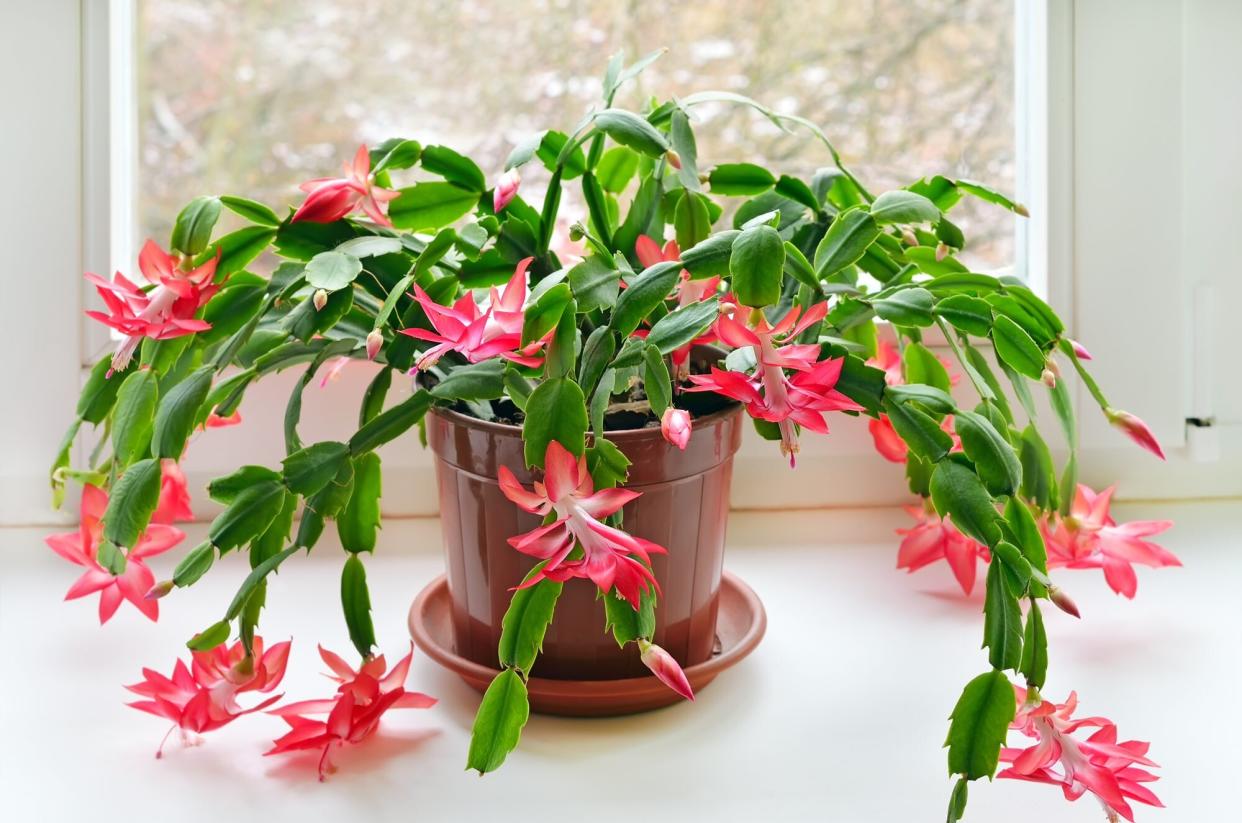How To Care For A Christmas Cactus

Getty Images
TABLE OF CONTENTS
On This Page
What's In a Name
How To Care for Your Christmas Cactus
Getting Your Christmas Cactus to Flower
Pinching and Pruning You Christmas Cactus
After-Bloom Plant Care
With gorgeous blooms in festive hues, Christmas cactus makes a popular holiday gift. The exotic-looking flowers open just in time for the holidays and provide weeks of color. Christmas cacti are long-lived plants, blooming year after year in shades of red, purple, peach, and white. Learn how to care for a Christmas cactus so you can enjoy these holiday beauties for years to come.
What's In a Name
Christmas cactus (Schlumbergera bridgesii) belongs to a group of closely related plants that includes the Thanksgiving cactus (Schlumbergera truncata) and Easter cactus (Schlumbergera gaertneri), each named for the holiday during which they typically bloom. Collectively, they are referred to as holiday cacti. The species most commonly available in stores during the holiday season is actually Thanksgiving cacti, not Christmas cacti, because its bloom time corresponds to the holiday shopping season. Regardless of which species you may be growing, basic plant care remains the same.
How To Care for Your Christmas Cactus
Though they belong to the cactus family, Christmas cacti are native to rainforests, not deserts. In their native home in Brazil, Christmas cacti grow as epiphytes in the crooks of tree branches. For successful growth indoors, choose a well-draining potting soil containing perlite and a container with good drainage holes. Christmas cacti are sensitive to root rot. Avoid overwatering plants and do not let water sit in the saucer beneath containers. Water plants when the soil is dry to the touch. Plants can be allowed to dry out slightly during the spring and summer months but take care to maintain even soil moisture during flowering.
Getting Your Christmas Cactus to Flower
Christmas cacti initiate flower bud formation in response to the shorter day lengths and cooler temperatures of autumn. The ideal conditions for flower bud formation include bright daylight followed by fourteen hours of continued darkness in a cool environment with temperatures between 60 and 68°F. Plants may not bloom if temperatures remain too warm and/or plants do not receive the required amount of darkness. These can be challenging conditions to provide indoors where artificial heating and lights are normally used.
One option is to move plants into a seldom-used room, heated garage window, or other location where lighting can be controlled until flower buds develop. Once flower buds develop, plants can be moved back to their normal location for display, as day length has no effect on flowering after the buds are set. For optimal bud development, provide dark night conditions for six weeks beginning in the middle of September. Maintain air temperatures between 60 and 68°F.
Christmas cacti are sensitive to being disturbed and may drop buds in response to sudden changes in temperature or humidity. Aim to provide similar conditions in the budding and display locations. Move plants as soon as buds appear to minimize bud drop. Continue to provide cool air temperatures. At 68ºF, flowering can last 7 to 8 weeks.
Another option is to place your Christmas cactus in a cool window and hope for the best. Cool temperatures can sometimes override day-length requirements. Plants grown with cooler night temperatures, between 50 and 59 ºF, will often set flower buds regardless of day length. However, excessive cold can be problematic as well, with plants dropping flower buds when temperatures drop below 50ºF, so pay attention to nighttime lows.
Pinching and Pruning You Christmas Cactus
A quick pruning in the summer months can encourage more flowers come winter. Pinch back stems in early June to promote branching, which in turn will result in more flowers at the shoot tips. Some growers also pinch plants back in September to create an even crown and remove immature stem segments. Immature stem segments (less than 1 cm) do not flower. Pinching back to a mature segment will encourage bud development. As a side note: cuttings can be used to propagate new plants for family and friends.
After-Bloom Plant Care
Once the flowers fade, reduce watering until growth resumes in spring. While plants tolerate bright light during bloom, they perform better under partial shade conditions during the spring and summer months. Indoors, that might be a bright east- or north-facing window. Plants also perform well when brought outdoors for summer. Look for a location with filtered sunlight, such as under a tree (remember, they grow in rainforests). Too much light can cause plants to appear pale or yellow.
Fertilize plants when active growth resumes in spring, providing a balanced (such as 20-10-20) fertilizer at half strength. Continue monthly feedings through August. A fall feeding with a low nitrogen fertilizer (for example 0-15-10) can boost flower bud formation. With proper care, a Christmas cactus can live for decades.

